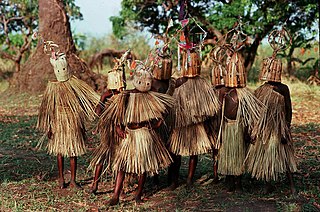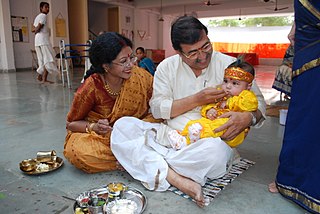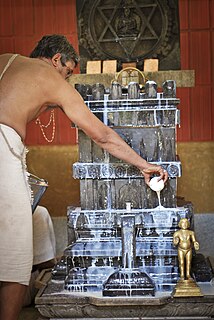Notes
- ↑ Rites in the Spirit: A Ritual Approach to Pentecostal/Charismatic Spirituality by Daniel E. Albrecht (1999). page 13. ISBN 1-84127-017-2.
Ritology, also called ritual studies or ritualistics, is the study of rites and rituals. The ritology focuses most directly on enactment and performance, that is, it gives priority to the acts and actions of people. A secondary focus is on the words, text, or objects used in the rituals. [1]

Dianic Wicca, also known as Dianic Witchcraft, is a Modern Pagan, goddess tradition, focused on female experience and empowerment. Leadership is by women, who may be ordained as priestesses, or in less formal groups that function as collectives. While some adherents identify as Wiccan, it differs from most traditions of Wicca in that only goddesses are honored.

A ritual is a sequence of activities involving gestures, words, actions, or objects, performed according to a set sequence. Rituals may be prescribed by the traditions of a community, including a religious community. Rituals are characterized, but not defined, by formalism, traditionalism, invariance, rule-governance, sacral symbolism, and performance.

Initiation is a rite of passage marking entrance or acceptance into a group or society. It could also be a formal admission to adulthood in a community or one of its formal components. In an extended sense it can also signify a transformation in which the initiate is 'reborn' into a new role. Examples of initiation ceremonies might include Christian baptism or confirmation, Jewish bar or bat mitzvah, acceptance into a fraternal organization, secret society or religious order, or graduation from school or recruit training. A person taking the initiation ceremony in traditional rites, such as those depicted in these pictures, is called an initiate.

A rite of passage is a ceremony or ritual of the passage which occurs when an individual leaves one group to enter another. It involves a significant change of status in society. In cultural anthropology the term is the Anglicisation of rite de passage, a French term innovated by the ethnographer Arnold van Gennep in his work Les rites de passage, The Rites of Passage. The term is now fully adopted into anthropology as well as into the literature and popular cultures of many modern languages.

Upanayana, also known as janai or janea, poita/paita, Yagnopavita, Bratabandha,Bratopanayan is one of the traditional saṃskāras that marked the acceptance of a student by a guru and an individual's initiation into a school in Hinduism. The tradition is widely discussed in ancient Sanskrit texts of Hinduism and varies regionally. The sacred thread is received by the boy during this ceremony, which he continues wearing from the left shoulder to the right crossing the chest thereafter. Generally, this ceremony should be performed before the advent of adulthood.
Victor Witter Turner was a British cultural anthropologist best known for his work on symbols, rituals, and rites of passage. His work, along with that of Clifford Geertz and others, is often referred to as symbolic and interpretive anthropology.

The Book of Rites, also known as the Liji, is a collection of texts describing the social forms, administration, and ceremonial rites of the Zhou dynasty as they were understood in the Warring States and the early Han periods. The Book of Rites, along with the Rites of Zhou (Zhōulǐ) and the Book of Etiquette and Rites (Yílǐ), which are together known as the "Three Li (Sānlǐ)," constitute the ritual (lǐ) section of the Five Classics which lay at the core of the traditional Confucian canon. As a core text of the Confucian canon, it is also known as the Classic of Rites or Lijing, which some scholars believe was the original title before it was changed by Dai Sheng.
The Roman Ritual is one of the official ritual works of the Roman Rite of the Catholic Church. It contains all of the services which may be performed by a priest or deacon which are not contained within either the Missale Romanum, the Pontificale Romanum or the Caeremoniale Episcoporum. The book also contains some of the rites which are contained in only one of these books for convenience.

Humanistic Buddhism is a modern philosophy practiced by Buddhist groups originating from Chinese Buddhism which places an emphasis on integrating Buddhist practices into everyday life and shifting the focus of ritual from the dead to the living.

Śrauta is a Sanskrit word that means "belonging to śruti", that is, anything based on the Vedas of Hinduism. It is an adjective and prefix for texts, ceremonies or person associated with śruti. The term, for example, refers to Brahmins who specialise in the śruti corpus of texts, and Śrauta Brahmin traditions in modern times can be seen in Kerala and Coastal Andhra.
Kemetic Orthodoxy is a new religious movement based on Kemeticism, which is a reconstruction of ancient Egyptian religion. It was founded in 1988 by Tamara Siuda, who remains its current Nisut or Pharaoh.

Polytheistic reconstructionism is an approach to modern paganism first emerging in the late 1960s to early 1970s, which gathered momentum starting in the 1990s. Reconstructionism attempts to re-establish genuine polytheistic religions in the modern world through a rediscovery of the rituals, practices and contextual worldviews of pre-Christian Pagan religions. This method stands in contrast with other neopagan syncretic movements like Wicca, and ecstatic/esoteric movements like Germanic mysticism or Theosophy.

Samskara are rites of passage in a human being's life described in ancient Sanskrit texts, as well as a concept in the karma theory of Indian philosophies. The word literally means "putting together, making perfect, getting ready, to prepare", or "a sacred or sanctifying ceremony" in ancient Sanskrit and Pali texts of India.
Kalpa means "proper, fit" and is one of the six disciplines of the Vedānga, or ancillary science connected with the Vedas – the scriptures of Hinduism. This field of study is focused on the procedures and ceremonies associated with Vedic ritual practice.
Liturgics, also called liturgical studies or liturgiology, is the academic discipline dedicated to the study of liturgy. Liturgics scholars typically specialize in a single approach drawn from another scholarly field. The most common sub-disciplines are: history or church history, theology, and anthropology. Although liturgics scholars using these approaches apply the principles of their respective disciplines to their research, all liturgics scholars focus their work in the ritual behaviors of the members of faith communities.

Myth and ritual are two central components of religious practice. Although myth and ritual are commonly united as parts of religion, the exact relationship between them has been a matter of controversy among scholars. One of the approaches to this problem is "the myth and ritual, or myth-ritualist, theory," held notably by the so-called Cambridge Ritualists, which holds that "myth does not stand by itself but is tied to ritual." This theory is still disputed; many scholars now believe that myth and ritual share common paradigms, but not that one developed from the other.
Eroto-comatose lucidity is a technique of sex magic known best by its formulation by English author and occultist Aleister Crowley in 1912, but which has several variations and is used in a number of ways by different spiritual communities. A common form of the ritual uses repeated sexual stimulation to place the individual in a state between full sleep and full wakefulness as well as exhaustion, allowing the practitioner to commune with their god.

Abhisheka means "bathing of the divinity to whom worship is offered." It is a religious rite or method of prayer in which a devotee pours a liquid offering on an image or murti of a God or Goddess. Abhisheka is common to Indian religions such as Hinduism, Buddhism and Jainism.

Chinese ritual mastery traditions, also referred to as ritual teachings, or Folk Taoism, or also Red Taoism, constitute a large group of Chinese orders of ritual officers who operate within the Chinese folk religion but outside the institutions of official Taoism. The "masters of rites", the fashi (法師), are also known in east China as hongtou daoshi (紅頭道士), meaning "redhead" or "redhat" daoshi, contrasting with the wutou daoshi (烏頭道士), "blackhead" or "blackhat" priests, of Zhengyi Taoism who were historically ordained by the Celestial Master.